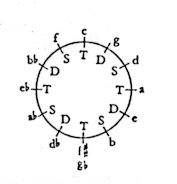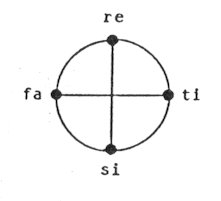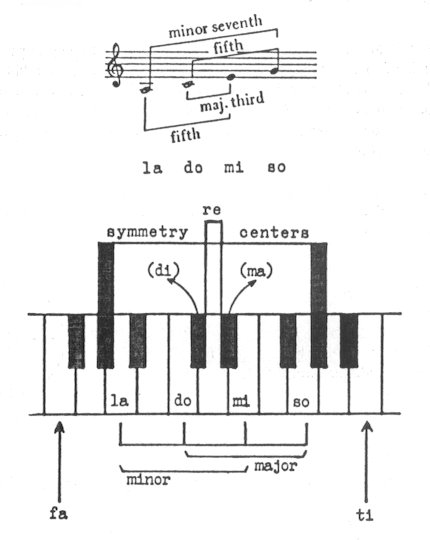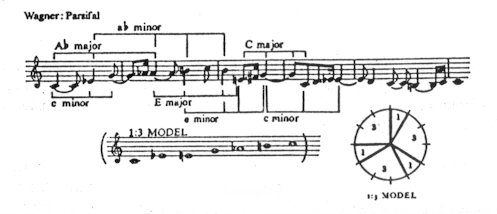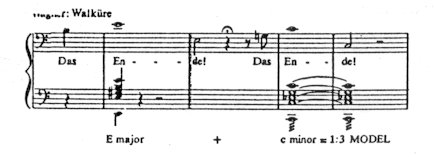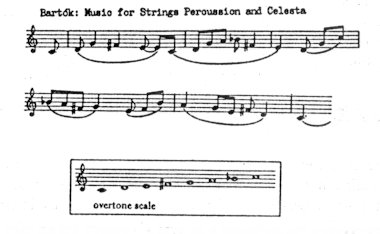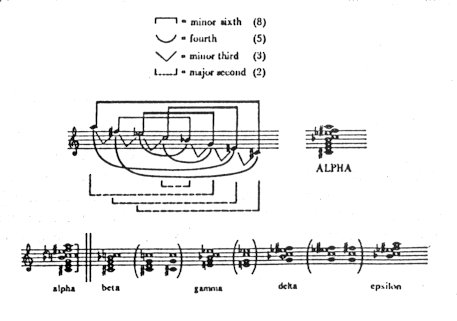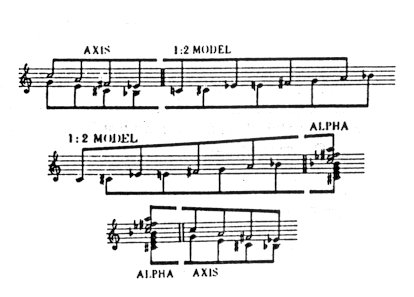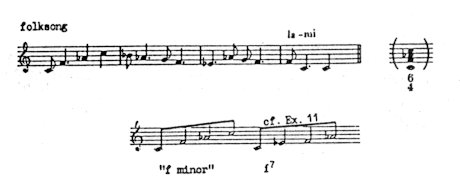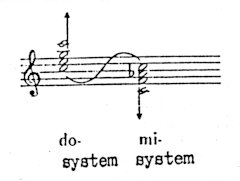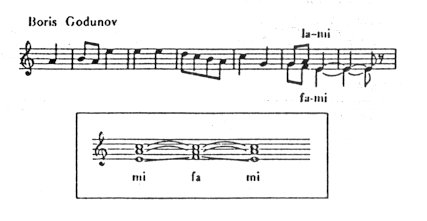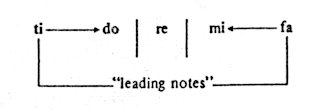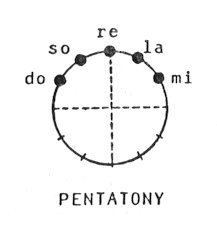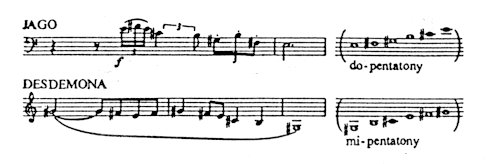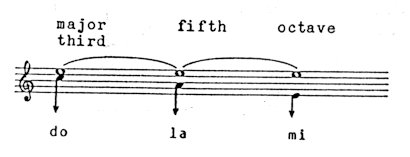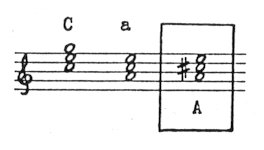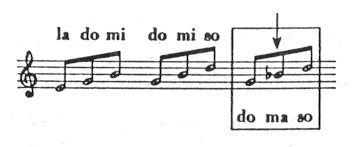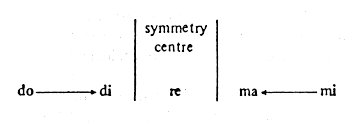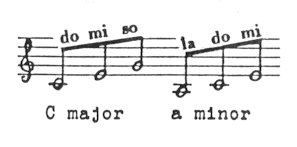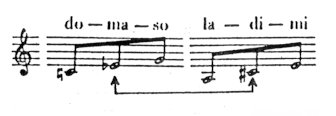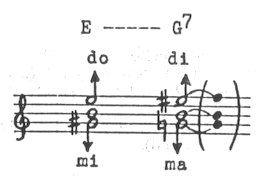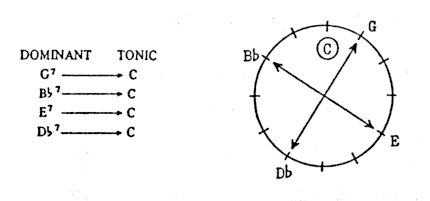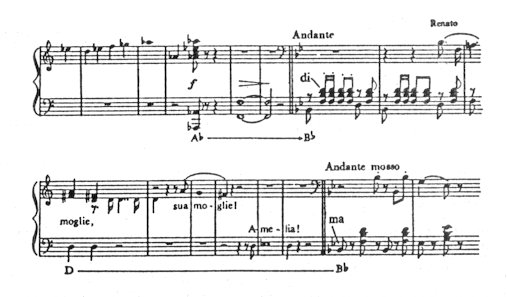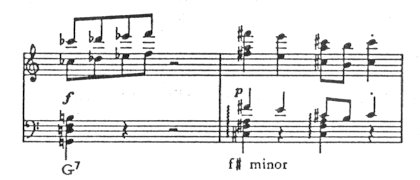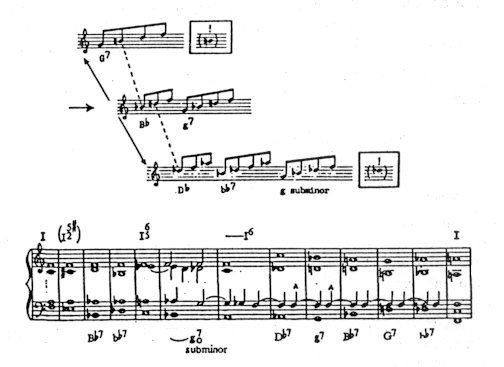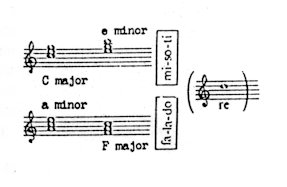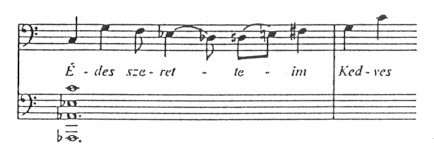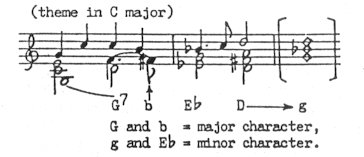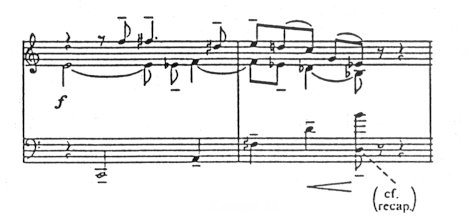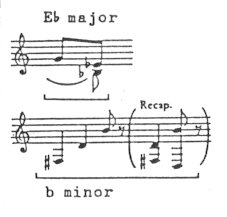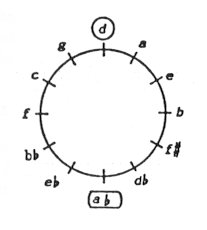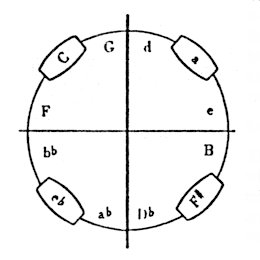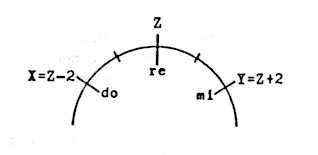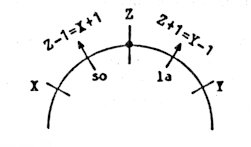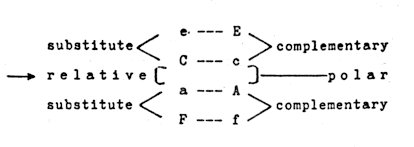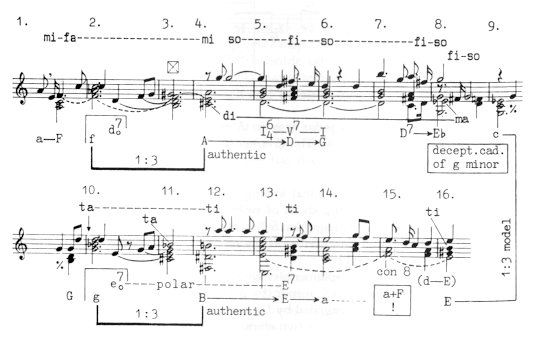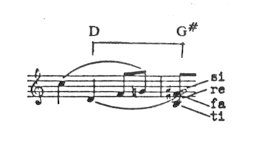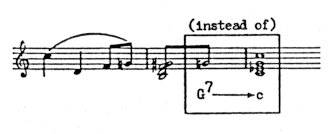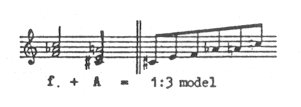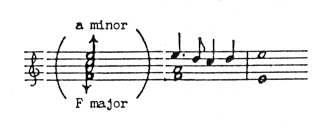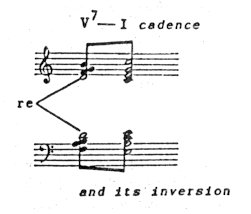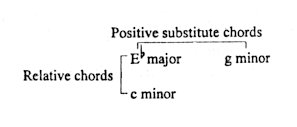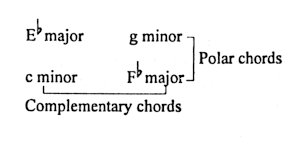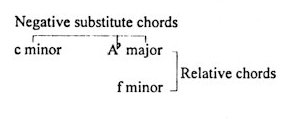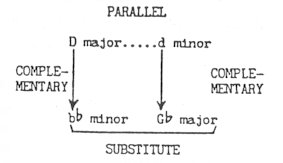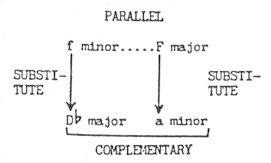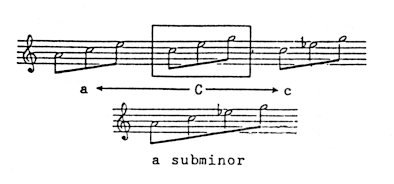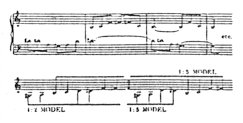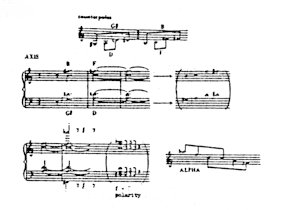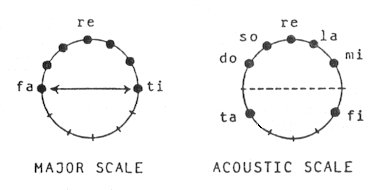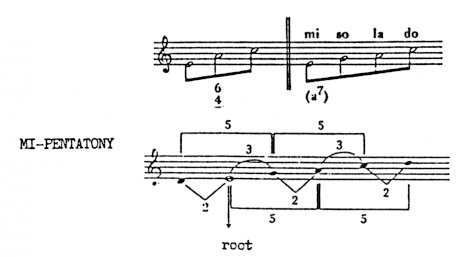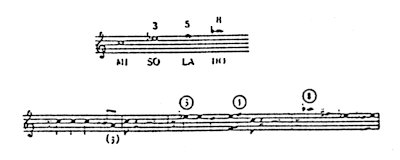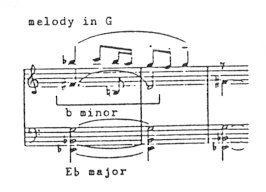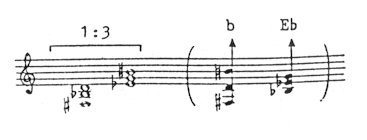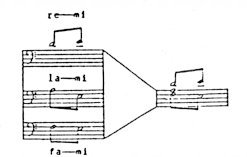SYMMETRIES OF MUSIC
Introduction "To be or not to be," this is the fundamental question
of music theory - insofar as "nonexistence" is associated with "atonality"
(i.e., the "entropy" of the tonal system), while "existence" is identified
with "tonal" order. In addition, tonality can be realized only through
the asymmetrical divisions of the tonal system, whereas symmetry (as may
be seen below) is equivalent to atonality.
The Symmetry of the Axis System In classical music, the individual degrees are related
as follows:
The authentic sequence E-A-D-G-C-F corresponds to the
functional series D-T-S-D-T-S. The "axis system" is nothing less
than the extension of this principle over the entire circle of fifths
(Example 1).
EXAMPLE 1 We have called this the "axis system" because similarly
to relative keys C major - A minor, or, C minor - Eb
major, the opposite poles - counterpoles - also acquire a tonic signification:
Each movement of Bartók's Music for Strings,
Percussion, and Celesta follows the same pattern: the framework of
the opening and closing movements is A-Eb-A
(beginning, mid-point, end), while movements II and III are founded on
the counterpoles C-F#-C and F#-C-F#, respectively1).
Polymodal Chromaticism Classical harmony is bound to seven-degree diatony; in the harmonic world of Romantic and twentieth-century music, however, the chords move within the closed sphere of 12-degree chromaticism. Accordingly, the former reflects a static way of thinking, while the meaning of the latter is determined by the relationship of harmonies to one another. For within the closed sphere of the fifth-circle it is as impossible to speak of fixed points of support - or "progress" - as it is nonsensical to call the distance covered on a sphere (or circle) "progress". For this reason the late works of Verdi and Wagner have proved to be an impregnable fortress to traditional theory: they stoutly resist all attempts at analysis. "Polymodal chromaticism": this is how Bartók himself termed his own style. The sensory process undergone in our consciousness can be described in the following way. For each successive chord we instinctively seek an answer to the question: Which is the chord that would follow according to the "natural" logic of music? And this we compare with the chord that in fact replaces it. The meaning of the chord will be determined by the difference in tension between the two. The lifeblood of this music is RELATIVITY: the system of potential differences between the tonal elements, which we may with total justification call the system of "modal" tensions. Various pedagogical disasters have led me to recognize that Romantic music will remain the terra incognita - blank spot - of music theory, unless it is approached through the devices of relativity. In our analyses, we treat the signs of "relative solmization" as mathematical symbols. Each of the 12 symbols designates a musical
character,
and if we recognize which sign represents light or darkness, which is accompanied
by a rise or a descent, which embodies a materialistic and which a spiritual
experience, why the content of one is expressionistic and the other impressionistic
- if in other words, through the help of signs, we can differentiate between
cold and warm colours, between positive and negative tension, if we know
for example that the "FI" lifts high and the "MA" hides a painful feature
- if we understand all of this, then, with no more signs than are necessary
to cover the tones of the chromatic scale, we shall have conquered something
of the realm concealed behind the notes.
Tonality and Atonality The 12 degrees of the chromatic scale can be arranged in three groups. First, the most peculiar feature of this tonal world is that its center is marked by a "black hole". The center - the zero point - coincides with the point of atonality. An important feature of classical harmony is that tonality can be established only through the "asymmetrical" divisions of the tonal system, because with a symmetrical division we would be unable to determine the root. Thus, tonality goes hand in hand with "asymmetry", while atonality with "symmetry". It is easy to see that the symmetry center of the C major or A minor scale is the D (=RE) note - where upward and downward from the D center each interval has its exact mirror image. In the key of C major, the dissonant "leading notes" of the dominant seventh are represented by the tritone B-F, while in the A minor scale by the tritone G#-D: i.e., precisely by the four notes that symmetrically divide the circle of fifths around the D symmetry center.
EXAMPLE 2 The tense and dissonant character of these "leading" notes (or rather, direction notes)2) is the direct consequence of the fact that they occupy a symmetrical position to the D-G# symmetry axis of our tonal system. This is well exemplified by the external look of white and black keys on our keyboard instruments where - related to D or G# - each note has its exact mirror image. The system of tension and resolution (dominant-tonic, e.g.) could scarcely have evolved without the antagonism between "tonal asymmetrical" and "atonal symmetrical" elements. Second (in fact this should be put in the first place): the most static pillars of our functional system are constituted by the DO-MI-SO and the relative LA-DO-MI triads (i.e., C major and its relative key, A minor). In the LA-DO-MI-SO (A-C-E-G) formula the
closest overtones
merge: this formula synthesizes the perfect fifth, the
major third and the minor seventh intervals (see Example
3). The relationship of these four notes is unique of its kind and
has no alternative. The overtone relations ensure an organic connection
between the tonal elements.
EXAMPLE 3 The third group contains typical "modal" elements. If we replace MI by MA in the C major triad, or, DO by DI in the A minor triad, the result will be a DO-MA-SO, or, a LA-DI-MI triad.
EXAMPLE 4 As a consequence, DI suggests a "major" quality, and MA suggests a "minor" quality. In addition, whereas DI and MA (C# and Eb) appear as tense dynamic elements, FI and TA (F# and Bb) emerge as static colour elements. FI and TA determine the character of the "acoustic (overtone) scale": see below. Looking from another angle, the upward-luring DI and FI produces a "chiaro" effect, while the MA and TA an "oscuro" effect. * * * * As stated above, an element that is symmetrical to everything represents the state of "physical death". The symmetrical division: that is, the repeated bisection of the circle of fifths - around the RE symmetry center - results in the discordance ("tension") points of this harmonic world (cf. Ex. 2). However, if we omit these "atonal" degrees (D-G# and F-B) from the 12-note system, model 1:2 is created: the basic scale of the chromatic system. We call it the 1:2 model because it arises from the periodic alteration of minor and major second intervals.
EXAMPLE 5 If we unite all the chords (major, minor, seventh, "subminor", etc.) belonging the same function (= the same "axis", e.g., C, A, F#, Eb), the 1:2 model is obtained.
EXAMPLE 6 Model l:5 represents another typical "axis sequence". For example, the combination of the C and F# fourths (= counterpoles) results in the scale presented in Example 7 .
EXAMPLE 7 Model 1:2 may be split up into two 1:5 models (see below)3). While the 1:2 and 1:5 models have a tonal character, model 1:3 annihilates tonality as a result of its augmented triad structure.
EXAMPLE 8 The C-Eb-E-G-Ab-B
1:3 model, for example, comprehends the following triads:
The idea of "annihilation" goes back to Romantic models. When Wotan in the great monologue of Die Walküre prophesies the twilight of gods, his words "Das Ende! Das Ende!" evoke E major and C minor harmonies.
EXAMPLE 9 In this case one triad neutralizes the other - since their notes combine in an atonal 1:3 model. This is why such triads express contrast in their content as well4). Triads of this sort are called complementary (annihilating)
keys. Right in the middle of example that states the death motif
from Tristan, the crisis is precipitated by the A major and F minor
complementary keys "extinguishing each other" (A major + F minor triads
= 1:3 model) (Example 33).
Acoustic Scale All elements enumerated above are symmetrically placed
- in relation to the RE symmetry center.
or the relative DO-MI-SO and LA-DO-MI (or the DO-MA-SO and LA-DI-MI) triads (see Example 3). The most characteristic formation in Bartók's diatonic system is the acoustic scale (or overtone chord): a major triad (e.g., C-E-G) with natural seventh (Bb note), augmented fourth (F#) and major sixth ("pastoral" sixth: A note). That is, a DO scale with FI and TA notes:
EXAMPLE 10 The acoustic scale became a static "colour chord" because it lacks the two sensitive notes that characterize the major scale: instead of FA and TI (F and B), FI and TA (F sharp and B flat) notes occur5). From this it becomes clear that the tones of the acoustic scale are also symmetrically arranged, around the RE symmetry axis (the mirror of FI being TA).
Elements of Melodic and Harmonic Origin Bartók's tonal system is dual. This duality is responsible for the mirror relation between the two systems. In my analitical studies, I have used the terms "pentatonic" and "acoustic" (system) to describe the two characteristic aspects of his music. Pentatony has its source in Eastern folk music; accordingly it is of melodic origin. The overtone (acoustic) system, on the other hand, is rooted in Western traditional music and is therefore of harmonic origin. The overtone system is controlled by the laws of physical consonance. (Harmony is perfect when the closest overtones are merged in it). In the major triad our ears register the most simple arithmetical proportions. A major chord represents an order based on the "simultaneous" sounding of notes - thus it is vertical in construction: it has a "spatial" extension. Pentatony, on the other hand, is of melodic origin. And since melody presupposes tones following each other "in time", it has a horizontal, linear extension. The primary distinguishing mark of pentatonic cultures is the descending DO-LA or SO-MI minor third and LA-MI fouth-step (as a cadence). The derivation of SO-MI and LA-MI cannot be traced back to the laws of physical consonance. Just the opposite. Pentatony reflects a peculiar tension (which could well be termed "life tension") and is justified by the organic-physiological disposition of our ears. This implies that while the overtone system suggests arithmetical proportions, the pentatonic system owes its tension-character to the most simple geometric progression - which governs organic development of "natural growth". For example, if every branch on a tree shoots a new branch in the next year - but the new branches are capable of shooting a fresh branch only from the second year on - then the number of branches displays an annual increase as follows: 2, 3, 5, 8, 13, 21, 34, 55, 89... These numbers result in the so-called Fibonacci sequence (advancing in the sequence, we approximate more and more the proportion of the geometric mean, i.e., golden seection). Pentatony, on an elementary level, is no less than the musical realization of the Fibonacci series. By adapting the Fibonacci numbers to the intervals, measured in semitones: 2 means a major second, 3 a minor third, 5 a perfect fourth, and 8 a minor sixth6).
EXAMPLE 11
Alpha Chords In the harmonic type most frequent in Bartók's chromaticism, that is, in the type "alpha", this principle has virtually become a rule. If we gave a computer directions to compose in our 12-note system closed patterns characterized by intervals of 2, 3, 5, 8 semitones (i.e., the Fibonacci intervals that can be created within an octave), the harmonic type thus obtained would necessarily agree with chord alpha. Without exception, the pentatonic intervals 2, 3, 5, 8 (or their octave) intertwine with every note of the chord.
EXAMPLE 12 Type alpha complies with two requirements. On the one hand, it derives from pentatony, and on the other hand, it is a typical axis model.
EXAMPLE 13
DO System and MI System In Western musical cultures the feeeling of tonality is created by the triad consonance: the "con"-sonance of the third and fifth intervals. It was the prelude and folk choruses of Mussorgsky's Boris Godunov that first made me feel that there exists a musical culture radically different from European harmonic thinking. The "archaic" quality of these melodies resides in their six-fourstructure. In the Hungarian folk song, shown in the Example 14, the keynote and tonal resting point is the C. Both the harmonic and the tonal meaning of the melody are determined by the "MI-pentatonic" structure. This harmony is not F minor - but it is a scale based on C as a root.
EXAMPLE 14
And this six-four harmony (C-F-Ab) is not the second inversion of the root-position F minor triad; consequently, it is not a secondary formation - but a musical element equal in rank with the root-position triads.Classical harmony treats the six-four chord as a hard dissonance, which requires a resolution. However incredible, in this ancient style of expression it is precisely the perfect fifth that marks the most vigorous dissonance!The basic step of the pentatonic six-four system is the plagal (descending) LA®MI cadence, while the basic step of classical harmony is the V-I dominant-tonic DO®SO cadence. Perhaps nothing demonstrates better the relationship of Western and Eastern ways of thinking than the fact that (in relation to the RE symmetry center) the SO®DO cadence of classical music and the plagal LA®MI cadence are precise mirror images of each other.
EXAMPLE 15 The DO and its reflection the MI can alike serve as a fundamental note.
EXAMPLE 16 In Bartók's Cantata Profana, D represents the tonal keynote. The beginning scale and closing scale of the work are each other's inversions (reflections: mirror images) - note for note.
EXAMPLE 17 The opening of the work rises out of MI-pentatony (D-F-G-Bb-C framework), while the framework of the closing theme is DO-pentatony (C-D-F#-A-B) - and both scales are coloured by degrees FI and TA. The closing scale will therefore take the shape of an acoustic scale, whereas in the opening theme we find a diminished fifth (TA) instead of a perfect fifth. In his Harvard lectures, Bartók himself made reference to the MI-scale in question7).
EXAMPLE 18
Phrygian Oriental Character A distinctive feature of melodies on MI as keynote is that the root is frequently reinforced with a "leading note" step: the Phrygian FA-MI turn. (NB8): the Phrygian scale is a MI-scale!), see Example 19 .
EXAMPLE 19 As in classical harmony, the TI®DO leading note step affirms the tonic DO keynote, so in this style of expression, the FA®MI step reinforces the MI tonal keynote. Again, in relation to the RE symmetry center, the TI-DO and FA-MI "direction notes" occupy a symmetrical position - and they move symmetrically as well.
EXAMPLE 20 The question here is why DO and MI are the most static points of the two tonal systems. As stated above, tonality can be established only through the asymmetrical division of the tonal system. If the tones of pentatony are arranged in a fifth order, the most perfect asymmetry is realized in the outer degrees: in DO and in MI. The individuality of DO-pentatony is decided by the fact that it can be exclusively built up of perfect fifths. The character of DO-pentatony is threfore the most "materialistic". On the other hand, that of MI-pentatony is the most incorporeal and disembodied, as not a single perfect fifth can be built on the MI root. Consequently, the MI-scale is "spiritual" (abstract) in character, suggesting an "inner" world.
EXAMPLE 21 This difference in character was already recognized by Verdi in Otello. The inaccessible figure of Desdemona is painted with MI-centered pentatony, whereas Iago's down-to-earth materialism is depicted with DO-based pentatony. It is remarkable that the notes of the two scales are identical.
EXAMPLE 22 On the other hand, degree RE - as symmetry center - proves to be the most unstable point in the scale: symbolically speaking, within the pentatonic scale the RE represents the "point of atonality", which is why it has such a floating effect9). One single pentatonic harmony (the opening chord of the opera!) is enough for Verdi to set the "storm music" of Otello whirling. The secret of the effect is that the chord is founded on RE.
EXAMPLE 23 The RE-character is further emphasized by the LA-DO-MI-SO
meaning of the G-Bb-D-F
notes.
Six-Four Type Melodies An important law of nature stands behind this principle. The major triad consists of the three closest overtones (octave, fifth, major third) of a common basic note - while in the MI-LA-DO six-four structure, the three closest overtones of MI, LA and DO "unite" with one another: they meet in a common note. That is, the octave of MI, the fifth of LA, and the major third of DO intersect each other in a point of concurrence (MI). In melodies of six-four character, this MI common note serves as a "point of comparison".
EXAMPLE 24 This is why the falling minor third motiv DO-LA, and the
falling LA-MI cadence is what we feel as a basic musical relationship:
"representing the earliest musical expression of human beings"' according
to Kodály. The explanation lies in the fact that related to
the common E note (see Example 24) the perfect fifth
(A-E) is a closer overtone relationship than the major third (C-E). And
even more so in folk songs with a LA-MI cadence, where the octave (E-E)
is a closer relation as the fifth (A-E): the weight of the MI final
note is therefore more powerful than that of the LA note. In the last resort,
"six-four" tonality (MI-pentatonic tonality and Phrygian tonality) turns
out to be the symmetrical counterpart of classical "major" tonality.
Modal Harmony Let us set out from a C major triad and its relative A minor. If the tonic C major is regarded as a DO-MI-SO chord, and the relative A minor as a LA-DO-MI chord, the A major harmony will then necessitate a LA-DI-MI interpretation:
EXAMPLE 25 The result is a unique elevation! Relative solmization makes a tangible distinction between the two kinds of majortriad: the C and the A. The DO-MI-SO and LA-DI-MI triads carry into effect quite dissimilar tonal qualities, different musical "characters". Both are major chords, but because of the DI degree (C#) the LA-DI-MI harmony is much brighter and more exalted than the simple major triad. In addition, the DO-DI rise produces the illusion of an ascension.
EXAMPLE 26 The difference of three key signatures between C-major and A-major denotes the same "modal" tension that was called axis tension earlier. (NB: chords based on identical axes - for example, C, A, F#, D# - show a difference 3 (or 3 + 3 = 6) accidentals.) The question suggests itself: What happens in the case of a descent of three flat key-signatures (e.g., when C major is exchanged for Eb major)? In this case, DO major is transformed into MA major (Ebmajor). The character of the Eb major chord is determined by the MA degree. The melody itself expresses a MI-MA decline (E-Eb theme opening in the Example). The difference of three key signatures between C major and Eb major displays once more an axis tension - now in the negative direction.
EXAMPLE 27 Or let us take a minor triad, for example an E minor chord, and replace it by the key lying three key siganatures lower - that is, by G minor. If we consider E minor to be a LA-DO-MI triad, then G minor will have a DO-MA-SO meaning, and again, its physiognomy will be determined by the sombre-sounding MA degree.
EXAMPLE 28 The recapitulation of the "Dies Irae" in Verdi's Requiem (Example 29) makes a cruel impression because it leads, not into the expected E minor - but into G minor: DO-MA-SO!
EXAMPLE 29 From all this we can draw the following. If a triad (either major or minor) is placed a minor third degree lower, the DO rises to DI - and the sound becomes "brighter". When the transposition is carried out in the opposite direction, the tone "darkens" because the MI sinks to MA (e.g., in the case of a C major-Eb major change, or A minor-C minor change, the E note is modified to Eb). The DO-DI change implies a rise of three sharps, the MI-MA change a descent of three flats. The symmetrical position of the DO-DI and MI-MA steps, in comparison to the central RE, is again evident.
EXAMPLE 30
Polar Tension On an elementary level, then, two key words govern modal harmony: DI and MA. However, the most remarkable axis tension is realized through polarity, in the relation of the farthest keys: in the distance of 3 + 3, that is, six key signatures - in the connection of A major and Eb major, or A major and C minor, for example. (The farthest points on the circle of fifths represent a distance of six steps.) It follows from the above that a "polar" tension character can be brought about by modifying DO to DI and, simultaneously, MI to MA. Let us take the simplest relation: C major and its relative A minor.
EXAMPLE 31 If we replace MI by MA in the C major chord, and DO by DI in the A minor, the result will be a DO-MA-SO or a LA-DI-MI triad, respectively.
EXAMPLE 32 The difference between the 3 flats of C minor and the
3 sharps of A major is six key signatures. Tristan's death motif is, in
fact, a materialization of this polar idea.
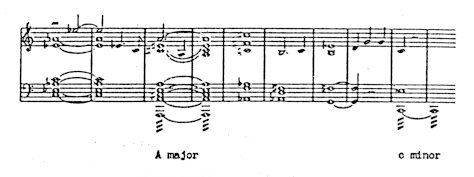
EXAMPLE 33 Let us have a look at an E major and G7 chord as an example. The meeting of the two results in a "polar" effect - as the DO-MI (E-G#) notes of the first chord become DI-MA / E# (=F)-G - in the second.
EXAMPLE 34 A reverse effect can be created when the two chords are interchanged, because the chord bearing polar tension is followed by a sudden "resolution". This motif recurs time and again, especially when something that has been veiled in mist comes suddenly to light! Beethoven also favoured this effect.
EXAMPLE 35
Dominant-Tonic It appears from the diagram of the axis system (cf., Example
1) that, in C tonality, a dominant-tonic cadence can assume four forms:
EXAMPLE 36 We begin with the "modal" dominant: Bb7 ® C After the dominant Bb major seventh, we would expect an Eb major tonic - and if (instead of Eb), C major surprisingly emerges, this means that the place of the expected DO basic note (Eb) has been occupied by a DI (note E)! The tonic has accordingly become sharpened and more elevated (See Example 37).
EXAMPLE 37 The inverse procedure of the modal dominant is the III-degree dominant (major third step downward): The dominant E seventh chord is succeeded not by the usual A major (DO-MI-SO), but by C major: a MA major chord!
EXAMPLE 38 This is why the III-I cadence is so heavily laden with death symbolism10). In Example 29, the III-I cadence casts a shadow of doom upon the "Dies Irae" theme: after the B major dominant, a G tonic emerges - hence the shock effect! In Example 9 we find a similar cadence: In short, the modal dominant-tonic cadence has a "positive" meaning, while the III-I cadence gives a "negative" impression. From the above it follows that a contrary effect can be attained if the same key has been prepared for by the lower major secend degree (=modal dominant), or the upper major third degree (=III-degree dominant). Two Bb major themes from Verdi's Ballo in Maschera suggest themselves here: the first introduced by the modal dominant (Ab major), the other by a III-degree dominant (D major). Renato's first aria is the manifestation of a friend's love and devotion. But the very same Bb major key, following right after the dramatic turn (after the exposure of Amelia in Act II), has an infernal impact and expresses scathing sarcasm11):
EXAMPLE 39 Of the dominant-tonic forms introduced above, there remains the interpretation of the Phrygian dominant (minor second step downward): Db7 ® C In the Phrygian dominant - just as in the classical V-I cadence - the "leading" role is played by the sensitive notes B and F (=TI and FA "direction notes"): the leading note TI pulls toward the root (DO), and the FA toward the MI:
EXAMPLE 40 The direction notes (TI and FA) halve the octave; therefore they are interchangeable - without any change in their relationship. Thus TI and FA are common notes in both the V-degree dominant and the Phrigian dominant (the third and seventh of the V-degree dominant is identical with the seventh and third of the Phrygian dominant). The difference between the Neapolitan chord and the Phrygian dominant is that the latter appears as a seventh chord with leading note ("direction note") attractions. This resolution is reserved by Bartók for a sudden "change of scene".
EXAMPLE 41 All things considered, the counterpart of the V-degree dominant is the Phrygian dominant, whereas that of the "modal" dominant is the III-degree dominant. It is easy to survey these interrelationships if we realize
that in the axis system - from the dominant G seventh chord - four different
tonic degrees can be reached:
These regularities may also be extended over the dominant and subdominant function as well. What is the role of DI and MA (C# and Eb) as compared to the tonic C major? It is the role of notes G# and Bb as compared to the dominant G major (i.e., the DI and MA of G major). And it is the role of notes F# and Ab as compared to the subdominant F major (or D minor). The 12 bell strokes from the forest night scene of Verdi's
Falstaff
are
quoted (the basic tonality is F major). By subjecting the
subdominant IV degree (Bb-D-F)
to a similar modification, that is, raising its basic note and lowering
its major third:
Thus, if in the subdominant IV- and II-degree chords (Bb major and G minor) the Bb is changed to B, we will get G major seventh; if, however, note D is changed to Db, then G subminor, Bb minor or Db major harmonies arise. All the permutations are exhausted by Verdi.
EXAMPLE 42
Substitute Chords The harmonies of Grand Romanticism frequently obtain some sort of "background" meaning - a secondary, transposed sense - and this takes place whenever a major triad is replaced by the minor chord lying a major third higher (e.g., C major substituted by E minor), - or contrariwise, a minor triad is replaced by the major chord lying a major third lower (e.g., A minor substituted by F major):
EXAMPLE 43 In the duet between Rigoletto and Gilda, the substitute chord (E minor replacing C major) reflects Gilda's spiritual purity: the substitute chord invests the melody with a "sublime" emotional content.
EXAMPLE 44 Let us think back to the beginning of Wagner's Parsifal, where C minor substitutes for the tonic Ab major. The "elevated", immaterial tone of the melody emerges from here: MI-SO-TI is the transfigured, unearthly element of late Romanticism. This is the source of its ethereal quality12):
EXAMPLE 45 As opposed to this sublime and elusive effect, at the beginning of the baritone solo in Bartók's Cantata Profana: the C minor melody is embedded in Ab major, and this Ab major colour lends the melody some sort of "emotional depth" - without veiling the C minor tonality.
EXAMPLE 46 Likewise at the opening of Act II of Tristan und Isolde: Wagner inserts the melody of G minor origin into an Ebmajor harmony: the tragic weight, the baleful atmosphere of the theme arises right from the FA-LA-DO substitute chord, as though a painful wound were ripped open!
EXAMPLE 47 The most peculiar feature of these examples is that contrary to classical experience: The meaning of the MINOR substitute chord is positive. And the other way round, the meaning of the MAJOR substitute chord is negative. It adds considerably to the individual signification of these chords that the positive substitute chord falls within the range of the dominant, whereas the negative substitute chord falls within the range of the subdominant. Needless to say that - in comparison to the central RE
- positive and negavite substitute chords (MI-SO-TI and FA-LA-DO, see Example
43) occupy a symmetrical position. The main thing is that - owing to
the upward pointing TI degree - the tonal quality of the MI-SO-TI substitute
chord is "positive", while that of the FA-LA-DO substitute chord is "negative"
- owing to the downward-pointing FA degree. From the notes of the C major
(or A minor) scale, six perfect triads can be formed: besides C
major and A minor, the one-sharp G major and E minor - as well as the one-flat
F major and D minor. Therefore13):
are identical with the positive and negative substitute chords, respectively. The gist of the matter is, however, that the major substitute chord intensifies the minor character of the theme - and vice versa. This means that in a minor melody, the FA-DO perfect fifth reinforces the minor third (DO) of the root, while in a major melody, the MI-TI perfect fifth fortifies the major third (MI) of the root. The opening Ab major chord of Example 33 brings out in bold relief the minor third (Eb) of the tonic C minor. - But in Example 45, the C minor chord increases the major character of the Ab major melody. Judging from the analysis of Romantic music, one might speak of the surprising frequency - one might even say preponderance - of substitute chords, which (taking into account the ambiguity inherent in Romantic harmony) reveals something symptomatic of Verdi's or Wagner's "double spirited" harmonies. We refer now to a frequent combination, based on substitute chords. The central theme of Bartók's Cantata Profana is unambiguosly conceived in C tonality, nevertheless the melody is accompanied by alternating E minor and Ab major harmonies. One of them (E minor) invests the C major with the positive substitute chord, the other (Ab major), however, increases the effect of C minor with its negative substitute chord. It is of crucial importance that the two chords meet in an 1:3 model, i.e., they reflect a complementary key connection. In the mature works of Verdi and Wagner, this combination often emerges as a "Leitmotif". We give an extreme example. The opening theme of Bartók's Fourth String Quartet is a true "challenge" to the aesthetes: perhaps there is no other theme in the Bartók oeuvre that has aroused so much interest. First of all, we compare this motif with a Romantic example. The riddle like sentence of Tristan ("The Queen of Silence bids me be silent: I grasp what she concealed, I conceal what she cannot grasp") is followed by a no less enigmatic motif:
EXAMPLE 48 In our example, bars 3 and 4 are based on the major dominant, whereas bars 1 and 2 rest on the minor dominant (G major and G minor, respectively). The positive trait of G major can be enhanced by the "positive" substitute chord: B minor (its specific colour is determined by the F# note):
EXAMPLE 49 On the other hand, if the negative feature of the minor dominant is to be enhanced, we must combine G minor with its "negative" substitute chord: Eb major:
EXAMPLE 50 Isolde's Liebestod motif (we quote below its birth in Act II) hides a similar structure; if we record it in C major tonality, the Eb major triad emerges as the negative substitute chord of the minor dominant):
EXAMPLE 51 Returning to Bartók's Fourth Quartet, bars 1-2 and 3-4 constitute a question-and-answer relationship. Therefore the end of the second bar corresponds to the traditional dominant "half-close cadence". (We note that in bars 1-2 the viola part is silent and thus a contrast - a "split" - is produced between the violins and the cello):
EXAMPLE 52 At the end of bar 2, the last chord is a B minor triad in the cello (= the positive substitute chord of the dominant G major) and an Ebmajor triad in the violins (= the negative substitute chord of the dominant G minor)14):
EXAMPLE 53 As a result, the two substitute chords - B minor and Eb minor - unite in an 1:3 model15):
EXAMPLE 54
The Ethos of the Axis System Comparisons are, by their very nature, delusive. Still, I would like to venture the following: classical harmony is to modal harmony what a geocentric world concept is to a heliocentric one. Let us arrange the tone set of Mozart's "Jupiter Symphony" in a circle of fifths. In a traditional representation, the tonic C will be placed at the "top" of the circle of fifths, in the center of symmetry of the system. However, earlier we came to the conclusion (and one glance at a piano keyboard will make us understand) that the symmetry axis of the C major scale is not C...but D (Ab=G#), in relation to which every note of the C major scale has a symmetrical counterpart - both upward and down. Of course, C major (with its zero key signature) occupies a special place in our system of musical notation. Moreover, as we can see on Example 56 below, F major with one flat and E minor with one sharp (or B major with five sharps and Bb minor with five flats ) are symmetrical opposites, as compared to center-note D. Wouldn’t it be more appropriate, in a depiction of the circle of fifths, to place the D at the top of the system and the Ab (G#) at the bottom? We would thus illustrate the actual relationship between the notes:
EXAMPLE 55 Now let us replace the preceding fifths with their corresponding keys. In the upper half of the circle, the chords F major and D minor, as well as G major and E minor, belong to the scale of C major (or A minor). Similarly, the chords Db major and Bb minor - as well as B major and Ab(G#) minor - all belong to the Gb (F#) major (or Eb minor) scale in the lower half of the circle. The relative C major and A minor keys rest on the same notes and have identical weight!
EXAMPLE 56 The symmetry thus obtained remains flawless even when the major triads are replaced by their parallel minor triads, and vice versa (for example, D minor and G major replaced by Dmajor and G minor respectively). Incidentally, it was Verdi in his late works who brought
this system to the highest perfection. If we were to classify - to "catalogue"
- the scales and themes of Don Carlos16),
we would discover not only the special meaning of each key, but also the
multidimensional
relationship between the keys. Let us take as an example a D minor
triad, which has the following characteristics:
Hence it follows that the system holds true only if every dimension of the system is verified and confirmed by the work’s dramaturgical content or poetical meaning. DOMINANT keys differ from the tonic ones by the "active"
force they exert (complying with the principles of the axis system). This
is how
The dominant minor chords can engender a rise, like the E minor and Bb minor keys, but a violent and tragic turn as well, like C# minor and G minor. SUBDOMINANT chords function in a similar manner:
The minor subdominant chords are distinguished
by their passivity:
According to our basic formula (Example 56), the symmetrical counterpart of Bbmajor is B minor. Is it not striking that the opera begins in Bbmajor (with two flats) and ends in B minor (with two sharps)? Or, why is it that in the nocturnal garden scene the settling effect of the F major terzett is followed by Eboli’s E minor revenge-aria (and why is the effect so convincing)? As has been seen, F major’s "mirror" is E minor. The turning point in the Posa-Philip duet (Philip's confession in F minor) is likewise preceded by an Emajor episode. In Eboli’s aria, the thought of Carlos’s "salvation" in Ab major and Carlos's "fall" in C# minor display a similar mirror relation. Following Posa’s Db major farewell, the revolution breaks out in Abminor (on all occasions see Example 56). The clue to this tonal riddle comes from Verdi himself; he places, so to speak, the clue into our hands. The key-sentence is sung by an anonymous actor: the "Monk" (whose disguise conceals Charles V). The first half of this sentence is about "worldly cares", the second half about ’heavenly consolation’. The Cbmajor tonality representing earthly concerns is contrasted with the Bbminor tonality denoting heavenly affairs. The mirror image of Cb major is Bb minor.
EXAMPLE 57 Once my art-history master projected slides of Giotto's fresco "The Mourning of Christ" and one of Rembrandt's landscapes inversely - in mirror view - to illustrate how the change radically altered the message of each picture. While playing a Cb (=B) major triad, let us look the piano keyboard in a mirror - or let us take a snapshot of the keyboard. If we reverse the left and right sides of the slide, the picture of a Bb minor triad will come into view! Also the upper and lower halves of our basic formula have a special meaning - they relate to each other as the empirical Aristotelian world to the Platonic one: the world of ideas. For example, C major is the image of "reality", while F# major is that of the Church and Religion. Or, A minor has a natural emotional charge, whereas its counterpole - Eb minor - conveys mystical feelings (e.g., Carlos' appearance at the court scene). C minor signifies dark passion, rebellious defiance (end of Act 1); but F# minor reflects the forlorn hope of redemption, etc. In the case of parallel major and minor keys (with the same name), one of the two chords belongs to a family of "natural" and the other to one of "modified" keys. C major, for example, stands for static force - while C minor is filled with furious temper. Or, D major rises over the commonplace; D minor, however, testifies the lack or exhaustion of life forces: oblivion, the longing for dream (Philip's aria). - Db (C#) major indicates salvation (it is the key of "fulfilled desire"); as opposed to this, C# minor points to a broken existence, death - caused by violence17). F# major is the temple of everlasting life; but F# minor symbolizes the misery of earthly existence; and so on. The difference between positive and negative
substitute
chords has already been discussed. For example,
Complementary (annihilating)
keys also conceal amazing contrasts. For example:
Polar major and minor chords (a difference of 6 key signatures) reflect the same contrast - in terms of content - as the pole-counterpole relations. It is worth noting that in the first version of the opera, Act I started with the choir of the woodcutters in Eb minor and concluded, polarly, in the C major march. We are led to the conclusion that a real "dictionary" of keys has evolved in this way. But, still, what about the Bmajor (= the key of earthly worries) in Act II, Scene 2: the chorus of the ladies of the court?! Actually, the text contradicts the music. The ladies are just feigning sentimental, "nice" feelings and cannot conceal that the courtly life is a treadmill for them (which is also to be guessed from the monotonous melody and the aimless repetitions), that they are weary of the interminable sighs and are merely exercising their duty. I would even venture to say that never in the history of music has a "boredom" more interesting than this one been composed. In my book Verdi and Wagner (published in English, 1988) I examined more than 500 dimensions of this musical "Rubic cube". Any one of the 24 major and minor keys can form 23 direct relations with the rest of the possible keys (to say nothing of the second- and third-degree relations). If we knew the character of only 23 keys, we could deduct the meaning of the unknown 24th key from these relations. One is also led to realize that the individual character
of the 24 diatonic keys result not from their absolute pitch, but from
the tuning of the notes within the different scales. It is
a historical fact that - around 1800 - the idea of the "well tempered"
tonal system was imperfectly realized: a Haydn movement in F#
minor, or Mozart's Magic flute in Eb
major sounded quite different to contemporary listeners and to us!
Computer Language of Music It was the introduction of the computer that brought about the most unexpected turn in these analyses. In 1983 I compiled a program, making use of the simplest combinations and permutations found in Bartók’s music. After running the program, the computer "dictated" - to our no small surprise - well-known melodic and harmonic passages from Tristan, Parsifal, Otello, and Boris Godunov. We must be content with some basic operations. In my programs no more than 3 numbers and 3 letters are employed. Each number or letter tells us something profoundly interesting and new about music and its perception. Number 1 indicates a perfect fifth. We mark the symmetry center of our tonal system (i.e., RE) with letter Z - while the root of the DO system is indicated by X, and that of the MI system by Y. If Z=0, then as shown in Example 58: X = Z – 2 and Y = Z + 2
EXAMPLE 59 The difference between X and Y is a major third: of all the equidistant scales, the augmented triad (major third + major third) is the only one in which the number of notes (three) cannot be divided by 2. Oddly enough, the symmetry center (Z) marks the "point of atonality". In the axis system, besides degree RE (=Z), there is to be found one more symmetry center - and this is the tritone of RE: the SI. In C major, this is the note G# (=Ab). In the language of geometry, we have: Z + 6 = Z – 6 (Naturally, in the case of modulation - or the choice of a new key - the value of Z changes). The three notes of the major and relative minor triads show an inverted relationship: Major: X, X + 1, Y Minor: Y, Y – 1, X Number 1 is an important element here, because it determines the tonal character of the chord (being a perfect fifth). Both X and Y are included in the tabulation above. Number 3 expresses a "modal" change - according to the fact that in the axis system a modal (parallel major-minor) change implies a difference of 3 key signatures. Let us take the simplest case: LA-DI-MI and DO-MA-SO; this time, a symmetry worked out like that:: DI = Y + 3 and MA = X – 3 Logically, if number 3 is related to the Z center (=RE), it signifies a "dissonant" note (=sensitive note, "direction note"): Z + 3 = TI Z – 3 = FA The tritonic relationship between the two notes (TI and FA) is expressed in the difference of six (3+3) perfect fifths. Note the "outward" and "inward" acting force functioning in TI and FA, respectively18). It is no accident that in the subdominant D minor and dominant G major the D note (=Z) plays the role of the common note. In the subdominant chords we find a FA note (Z – 3) and in the dominant a TI note (Z + 1). Moreover, the subdominant chord involves a LA note (Z + 1), while the dominant chord a SO note (Z – 1). And because as indicated in Example 59, LA: Z + 1 = Y – 1, and SO: Z – 1 = X + 1 We see that these two notes provide for the "connecting link" between Z and X on the one hand, and between Z and Y on the other. That is, these two notes make the connection possible between T-S and between D-T, respectively. The formula of the positive and negative SUBSTITUTE chords
coincides with the psychological observation that we compare the former with point Y (see the role of Y and Y + 1 in the first chord) and the latter with point X (the second chord includes X and X - 1). Complementary keys express their "annihilating" quality in figures as well. As we know, the complementary key of C major is Abminor - while that of A minor is C# (Db) major. In both we find the note Ab (G#), that is, the symmetry center of our tonal system (Z + 6 = Z – 6). In the Ab minor complementary key the "direction note" TI (Z + 3) manifests itself, whereas in the C# major complementary key we find the "direction" FA (Z – 3). The most interesting is, however, the role of the third element: in the "negative" complementary key (Ab minor) the MA figures (i.e., X – 3), whereas in the positive complementary key the DI plays the same role (Y + 3). We give one single example. Let us harmonize an A minor melody with its relative major harmony, C major - and these, in turn, with their substitute chords: F major and E minor, respectively (cf: Example 43). If these triads are interchanged by their parallel triads (i.e., E minor by E major, C major by C minor, A minor by A major, and F major by F minor), the symmetry remains untouched. The difference between C minor (with 3 flats) and A major (with 3 sharps) is six accidentals and reflect a polar opposition. On the other hand, F minor and A major are complementary keys - annihilating each other. Similarly: E major and C minor reveals the same relationship.
EXAMPLE 60 The exposition of Act I in Wagner's Tristan brings into focus the following sentence Wherever I stand.
EXAMPLE 61 Our analysis has been centered around five moments: 1. "Auf jeder Stelle wo ich steh..."
Where is Tristan standing? Above the maelstrom: in the gate of hell,
so to speak (bars 1-4).
We consider these points one by one. 1. The MI-FA step has the pressing force of a steam boiler. Wagner begins the melody with A minor and its negative substitute chord: F major (cf. Example 61). [The precipitous fall at the beginning of the Death motif. (Example 33) was also effected by the motif bursting forth in the negative substitute chord, in place of the tonic.] 2. And conversely, the musical analogy of "Frauen höchster Ehr'" is the upshooting FI-SO (the sweeping dash of notes F#-G in bars 5-8). Wagner further heightens the light effect by raising bars 5-7 to the dominant (G). The "balance" tips over at the meeting point of the two worlds - in bar 3: the transition is marked by the two "atonality points" of our tonal system RE-SI (D-G#) and FA-TI (F-B):
EXAMPLE 62 In bars 2-3 it is already the Cminor that we sense to be the tonic - which means that the 3rd bar (dominant diminished seventh) should be continued in this way:
EXAMPLE 63 Nevertheless, it resolves not to C minor, but in a polar way to A major (6 accidentals away), entering thereby into a new sphere (bar 4). The C minor triad manifests itself openly as well in bar 9 (!) Stripping all the fringes and frills off the melody, we find that the two surprises in the first line are produced by: the F minor - A major complementary keys ("the colour of Tristan's face changes"), and the A major (bar 4) and Eb major - C minor (bars 8-9) polarity: the symbolic "slap"; the two areas are hallmarked by DI and MA. All this is extended by another two elements. The strophe sets out from A minor and its negative substitute chord, F major. This itself carries a big charge of tension. But Wagner does not stop here: he submits the two chords to another "load test" by converting A minor into A major (bar 4), and F major into F minor (bar 2). With this he creates the possibility for a "metamorphosis", since the F minor + A major triads are complementary keys, annihilating each other (producing jointly a 1:3, model):
EXAMPLE 64 The chords act like litmus paper, which changes colour according to the acidity or alkalinity of solutions: the change of colour in bar 4 is eloquent proof of this. In short, if we combine three principles:
then the tonal structure of the theme can be clearly seen. In addition, the end of line 1: C minor, and that of line 2: E major, also reflect a complementary (annihilating) connection. (We note that the F minor chord of bar 2 rhymes with the D major of bars 5-7, in a polar way. 3. "Frauen höchster Ehr'": bar 8 gives away that the "praise" actually conceals "contempt". As if Tristan wanted to push Isolde off the throne! We, hear a two-step negative cadence: "G minor" - in place of G major, indeed, its deceptive cadence! This is how the word "Ehr" acquires a rough and brusque tone (Eb major = MA major), instead of reverence19). It has repeatedly been pointed out that the deceptive cadence of the minor dominant is tantamount to MA major (Eb major), which is suggestive of sinister passions. And - typically of Wagner - even the deceptive cadence of the deceptive cadence is employed: C minor (bar 9). 4. The second line of the melody (from bar 10) repeats the first line a major second degree higher; this turn is known to represent the most powerful form of intensification: Tristan raises his voice (by way of explanation: a major second rise indicates a change based on the "modal dominant-tonic" principle). The litmus effect is elicited again: G minor (bar 10) and B major (bar 12) are complementary (annihilating) chords. The four analogous chords (bars 24 and 10-12) encompass all twelve degrees of chromaticism:
5. We have arrived at a point at which Tristan utters his famous sentence: Wie lenkt' ich sicher den Kiel zu König Markes Land? I can't be far from the truth, claiming that bars 13-16 condense the gist of the Tristanian Lebensgefühl. According to Wieland Wagner, Tristan's boat is headed toward the realm of the Night, toward Nirvana, over the "Styx". The Oriental effect of the two final chords is due partly to the Phrygian mode20) (bars 15-16), partly to the "six-four tonality" of bar 13 but first of all to bar 15, which simultaneously condenses the A minor + F major triads - known from the starting bar: it unites the tonic minor chord with its negative substitute chord (F major):
EXAMPLE 65 This is the very moment when stage action metamorphoses
into mythology: the "'sea" becomes perceivable in its full depth21).
Image: Reflected by Mirror If the dominant-tonic cadence, characteristic of "Western" music, is represented by the G7-C harmonies, we can take it for granted that the mirror image of this formula (related to the RE symmetry center) gains an "Oriental" colouration.
EXAMPLE 66 This cadence is well-known to us from Tristan (Prelude of Act Ill). Its oriental colouration originates from the FA-MI (F-E) "direction note" step:
EXAMPLE 67 What our theoretical mind does is typically "left-hemispheric" thinking. Bartók himself suggested that "human" nature and spirit are indivisible: an organic coherence can be discerned between distant - and seemingly irreconcilable - styles. In Romantic music, the individual harmonies appear not as self-contained "atoms" but as elements of a "giant molecule" (a compound arrangement of tones resulting in an organic structure and unity) where all particles are associated and closely interlinked; and as a consequence, every chord has an organic connection with every chord. Starting from a major melody (e.g., from Eb major), the substitute chord of the tonic is G minor, and its relative key is C minor:
The question arises: Which is the chord that could establish a contact between these two triads (i.e., G minor and C minor)? The complementary key of C minor is Fb major - while the polar key of G minor is likewise Fb major (= a difference of 6 key signatures):
Example 68 quotes the "light-footed" dance of the priestesses from Verdi's Aida. The theme consists of the four elements outlined above. Even the closing cadence (at the end of bar 4) contains a G minor triad22).
EXAMPLE 68 We try to find now the symmetrical counterpart of this motif. Therefore we choose a minor theme: C minor. In this case, its substitute chord is Ab major (= a negative substitute chord), and the relative key of this Ab major is F minor:
This time, the "connecting link" between F minor and C minor is created by A major - because the A major triad constitutes the complementary chord of F minor and the polar chord of C minor (= a difference of 6 accidentals):
In Ex. 33 we quoted the Death-motif
from Wagner's
Tristan. The basic tonality is C minor.
The structure of the theme is decided by the chords described above.
In our first example (Ex. 68), the
positive substitute
chord prevails; in our second example (Death-motif, Ex. 33),
however, the negative substitute chord stands out. What is
more, both examples start with the substitute chord of the tonic.
In the Verdi example we find tonic and dominant, whereas the Wagner
example shows tonic and subdominant chords only. As a matter
of course, this duality predestines the content, the character, the colour,
and even the "lifestyle" of the two melodies. This is why we called
the Verdi theme at issue the "light-footed" dance of the priestesses.
And this is how Tristan and Aida can meet on the deck of the computer.
APPENDIX I The perception of music is based on our capacity to identify musical sounds by their relationship to a given key (or root) - not immediately by their ’absolute’ pitch. The sense of perfect pitch is a faculty that is in most cases innate and independent of the direct perception of music. The advantage of relative solmization (Kodály method) over absolute tone names is that it also expresses the musical "meaning" (function) of the notes. According to Kodály’s musical concept, each major
scale has a DO-RE-MI-FA-SO-LA-TI -DO, and each minor scale a LA-TI-DO-RE-MI-FA-SO-LA
significance.
For example, in the C major (or A minor) key:
Or, the chromatic scale in the E major or C# minor key runs as follows:
EXAMPLE 69 If the reader is familiar with the principles of the figured bass (Generalbass), relative solmization turns out to be a very simple method. For instance, if degree I = DO, then degree V = SO, and degree VI = LA, etc. Relative solmization is more than just a matter of learning how to write and read music. There is but one way to examine Romantic - ''modal" - music (inclusive its computer analysis): by adapting the symbols of relative solmization (in which, for example, the closedness of the system is expressed by the fact that DO-DI and MI-MA are not only derivatives but also mirror images of each other). This method can tell us something profoundly new about the nineteenth and twentieth century music. I think, upon the model of the words astrology and astronomy,
we should call Kodály's concept (instead of musicology) "musiconomy":
giving this a name.
APPENDIX II Finally,I would like to cite a few examples- to be more precise, a few mental excercises. First example. Starting from the parallel keys (eg., from D major and D minor) the complementary (annihilating) key of the former is Bb minor and that of the latter is Gb major - because D major + Bb
minor = 1: 3 model,
The Bb
minor and Gb major thus
obtained are substitute chords.
EXAMPLE 70 Second example. We take once again parallel keys as our
point of departure (e.g., F minor and F major). The substitute chord of
the former is Db major,
and that of the latter is A minor. These two triads together form
an 1 : 3 model; that is, they are complementary (annihilating)
keys of each other.
EXAMPLE 71 Whereas in the first example the substitute relationship was reached via the complementary keys, in the second the complementary relationship is reached via the substitute keys. Philip's famous monologue (in Act IV of Don Carlos) is in D minor and D major (= the contrast of sleep and awakening to consciousness). Immediately after the monologue, the Grand Inquisitor intervenes, and - at the climax - he intrudes in a tonal sphere most alien to Philip's D minor and D major harmonies.
EXAMPLE 72 Let us compare these chords with Example 70! Philip ends his aria in D major, while the entry of the Grand Inquisitor is supported by F minor; therefore a polar relationship (a difference of six accidentals) is created between the two tonalities. The duet of Philip and the Pontiff moves from F minor to F major. According to the evidence of Example 71, F minor can be substituted by Db major - while the F major's substitute chord is A minor. Db major and A minor are complementary keys, and it is precisely these chords that take root in the exposition. We now mention a characteristic "circular" symmetry. Typical
"negative" effects can be produced by:
From the periodic alternation of these two principles a sequence of negative content can be generated:
EXAMPLE 73 The auto-da-fé scene (Act III) is strung on the thread of the foregoing sequence.Exposition and recapitulation are rooted in E major. The "wish for peace" in Ab (choir in the middle part of the scene) receives a positive content, while C major returns as a painful memory: a reminiscence of the Freedom duet appears when Carlos is disarmed by Posa (see Example 73, E minor emerges as a funeral march). In Example 8 (p. 234) we find the same
sequence; this time sustained notes (Ab
and G) emphasize the complementary keys Ab
major and E minor.
NOTES 1. The axis system developed from the classical major-minor tonality in two ways: from the correspondences between relative and parallel major-minor chords. In the simplest case the relative key of C major is A minor, and its parallel key is C minor:
Example N1 This combination carries within itself the very germ of the so-called subminor chord as well: A-C-Eb-G (a diminished triad with a minor seventh note). The widespread use of the subminor is very likely due to the "Tristan-chord", which became a true emblem of Romantic music. 2. More precisely, the so-called "sensitive" notes (I prefer to name them: the direction notes), i.e., the "leading" note and the seventh note of the dominant chord (e.g., in the chord G7, the notes B and F). 3. In Bartók's Microcosmos piece "From the Island Bali", the left and right hands each play 1:5 models, which togther create a full 1:2 model.
Example N2 Model 1:5 has a polar construction of its own, as apparent from the final chords of the piece.
Example N3 4. The entire tonal plan of Bartók's
Bluebeard's
Castle is based on complementary relations: F# minor is
the key of "Night" and C major that of the "Light" (the lowest and highest
points in the circle of fifths). C major can be destroyed by means of the
Ab minor key - thus the
latter is associated with "death" symbolism. On the other hand, the
night's F# minor can be defeated by, Bb
major - thus it became the symbol of "love". The four triads together
extend over the entire chromatic scale:
5. The rainbow colour spectrum in optics is analogous to the natural overtone scale in music. The term "acoustic scale" is mine (1947). The acoustic harmony became a static colour chord because it lacks the two "direction notes" (sensitive notes) that characterize the major key: FA and TI (= outer points, of the system).
Example N4 6. If we regard E as a MI note, the MI-pentatonic scale takes shape as shown in the Example below.
Example N5 Three technical terms must be introduced here, all of them hiding a common idea: (a) the MI-pentatonic framework, (b) the Phrygian root character, and (c) the six-four structure based on MI as a keynote. The archaic quality of East-European six-four type melodies lies in their MI-pentatonic or Phrygian scale. The MI final note is usually reinforced by a falling LA-MI cadence or a FA-MI "direction note" step, which gives the melody a Phrygian colouration. 7. In Bartók's Sonata for Two Pianos and Percussion, the principal theme of the opening movement fills out the MI-pentatonic frame; if C = MI, then MI-SO-LA-DO = C-Eb-F-Ab,
Example N6 whereas the principal theme of the finale gains a firm DO character (C major triad background) - being at the same time a perfect acoustic scale:
Example N7 8. A remarkable Phrygian cadence from Bartók's Violin Concerto:
Example N8 9. In Bartók's Microcosmos piece "Melody in Mist", for example, the "mist" is visualized by RE-pentatonic harmonies. 10. Or suggests destructive ideas, like the great bluff in Faistaff's "Monologue on Honour" - accompanied by a III-I cadence (E major tonic, and B dominant seventh followed by G major):
Example N9 11. However, the modal dominant carries a "positive" - and the III-degree dominant a "negative" meaning only if the dominant is followed by a tonic resolution. If the dominant and tonic chords are exchanged, their intention will also be reversed. In the case of a I-Ill turn,
the E7 will be associated with the A major
key - which lies 3 sharps higher than C major. Thus the III-degree
will produce here the effect of ascent: a "light" effect (chiaro).
The lofty effect of the Aida theme, at the opening theme of the
overture, may be ascribed to the fact that the tonic D is succeeded by
a III-degree dominant: F# major (bar 9). Liszt's Liebesträume
also originates in a I-III turn (Ab
major --- C7 in bars 1-2). - And inversely, in the case of the
modal
dominant following upon the tonic I-degree,
the Bb7 will be related to the Eb major key - which lies 3 flats lower than C major. The modal dominant will thus produce the effect of descent: a "shadow" effect (oscuro). It is no mere chance that the tonic-modal dominant turn became the leitmotif of "consternation" and stupefaction in Verdi's operas. The dramatic turning-point in Rigoletto: the blast of "La sua figlia" is evoked by the Eb major modal dominant, subsequent to the tonic F. 12. Some of the most beautiful examples are to be found in Verdi's Requiem. The opening theme (in A minor) is introduced as a mournful funeral music. But the very same A minor melody at the recapitulation receives a transcendental complexion, since it reappears after an F major cadence, that is, as the positive substitute chord of F major:
Example N10 13. Cf. L. Bárdos: Natural Tonal Systems. 14. The same combination (Eb major and B minor) occurs in Bartók's Cantata Profana and Dance Suite; the theme itself is conceived in G tonality:
Example N11 15. The Klangcharakter is defined by the fact that in this instance the 1:3 model consists of two separate augmented triads:
Example N12 16. "Don Carlos" was the opus by which Verdi intended to regenerate the opera genre and to create a new tonal "ideal". Such achievements are the Monk's key-sentence, the replacement of the original ballet by newly composed prelude in Act III, the reconstruction of the Posa-Philip duet, the two versions of Carlos's romance (one in C, the other in Bb), the innovations of the great quartet of Act IV, not to mention the insurrection scene (reflecting the strict logic of a twentieth century composition - insofar as the insurrection proves to be a variation on the key-sentence of the Monk, etc.). 17. For example, Eboli's fall, Posa's funeral music, the breaking of Elisabeth's resistance in Act V. 18. FA represents the "emotional" element of music! 19. In bar 6 we find G major, while in bar 8 it is the deceptive cadence of G minor that appears. This contrast is responsible for the "slap"-like effect. 20. The harmonies of bars 15-16 are based on the most peculiar Phrygian turns:
Example N13 21. The formula preparing the dénoument is one of the oddest products of Romantic music. The "TI major" chord (B-D#-F# in bar 12) borrows its peculiar quality from the MA and FI notes: the D# (= Eb) note gains a MA coloration, while the F# gains a FI character. The chord couples the mortal "human" element (= MA) with the uplifting "spiritual" element (= FI), it is small wonder that the chord ushering the melody to its "destination" is the B major chord at issue. 22. And as a "polar" colour, the "seventh
chord" Fb-Ab-D
also blends into the Bb
dominant seventh.
|
